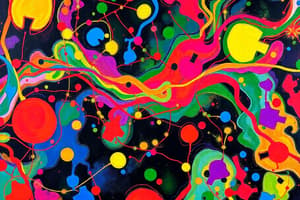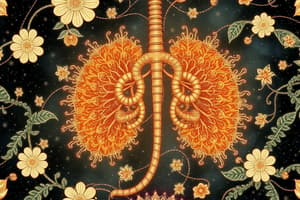Podcast
Questions and Answers
What drives ATP synthesis in the chemiosmotic hypothesis?
What drives ATP synthesis in the chemiosmotic hypothesis?
- Electron flow only
- Chemical reactions only
- Proton gradient across a membrane (correct)
- Oxygen consumption
The electron transport chain (ETC) is solely responsible for producing ATP.
The electron transport chain (ETC) is solely responsible for producing ATP.
False (B)
What is the role of ATP synthase in cellular respiration?
What is the role of ATP synthase in cellular respiration?
It synthesizes ATP from ADP and inorganic phosphate using the energy from the proton motive force.
During cellular respiration, the proton gradient is created across the ______ membrane.
During cellular respiration, the proton gradient is created across the ______ membrane.
Match the following terms with their descriptions:
Match the following terms with their descriptions:
Which statement correctly distinguishes between the sources of energy in respiration and photosynthesis?
Which statement correctly distinguishes between the sources of energy in respiration and photosynthesis?
The proton gradient in photosynthesis occurs across the thylakoid membrane.
The proton gradient in photosynthesis occurs across the thylakoid membrane.
Explain what is meant by 'proton motive force.'
Explain what is meant by 'proton motive force.'
Flashcards
Electron Transport Chain (ETC)
Electron Transport Chain (ETC)
A series of protein complexes embedded in a membrane (like the inner mitochondrial membrane) that transfer electrons and release energy.
Proton Pumping
Proton Pumping
The process of actively moving protons (H+) across a membrane, creating a difference in concentration and electrical charge.
Proton Motive Force (PMF)
Proton Motive Force (PMF)
The potential energy stored in the proton gradient across a membrane, driven by the difference in proton concentration and charge.
ATP Synthase
ATP Synthase
Signup and view all the flashcards
Chemiosmosis
Chemiosmosis
Signup and view all the flashcards
Oxidative Phosphorylation
Oxidative Phosphorylation
Signup and view all the flashcards
Cellular Respiration
Cellular Respiration
Signup and view all the flashcards
Photosynthesis
Photosynthesis
Signup and view all the flashcards
Study Notes
Introduction
- The chemiosmotic hypothesis explains how ATP is synthesized during cellular respiration and photosynthesis.
- It proposes that a proton gradient across a membrane drives ATP synthesis.
Key Concepts
- Electron Transport Chain (ETC): The ETC is a series of protein complexes embedded in a membrane (e.g., the inner mitochondrial membrane).
- Proton Pumping: As electrons move through the ETC, protons are actively pumped from one side of the membrane to the other, creating a proton gradient.
- Proton Motive Force (PMF): This gradient represents potential energy due to the difference in proton concentration and charge across the membrane.
- ATP Synthase: This enzyme is embedded in the membrane and uses the energy from the PMF to synthesize ATP from ADP and inorganic phosphate (Pi).
- Chemiosmosis: The movement of protons across the membrane through ATP synthase, driving ATP synthesis.
- Oxidative Phosphorylation: The process in which ATP is generated from the energy of the proton gradient generated by the ETC, particularly in cellular respiration.
The Process
- Electrons are passed along the ETC.
- As electrons move through the ETC, protons are pumped from one side of the membrane to the other, creating a proton gradient. This process is coupled to the flow of electrons.
- The buildup of protons on one side of the membrane generates a high concentration gradient (chemical gradient) and a difference in electrical charge (electrical gradient). This combination of forces is called the proton motive force.
- Protons flow through ATP synthase. The flow of protons through ATP synthase causes the enzyme to rotate, which then leads to the synthesis of ATP.
- ATP synthesis is a direct consequence of the flow of protons.
Differences Between Respiration and Photosynthesis
- Similar Processes: Both systems utilize proton gradients to drive ATP synthesis by chemiosmosis.
- Different Sources of Energy: In respiration, the energy comes from the oxidation of organic molecules. In photosynthesis, the energy comes from light. This energy ultimately powers the electron flow through the ETC.
- Different Locations of ETCs and ATP Synthase: Respiration happens in mitochondria; photosynthesis happens in chloroplasts.
- Location of Proton Gradient: During respiration, the proton gradient is created across the inner mitochondrial membrane. In photosynthesis, the gradient is across the thylakoid membrane.
Importance of the Hypothesis
- Explains ATP synthesis in both cellular respiration and photosynthesis in a unified framework.
- Explains how energy is converted and stored in biological systems.
- Provides a mechanistic understanding of how metabolic processes are regulated.
- Demonstrates the importance of membrane structure and function in energy transduction.
Limitations
- While the hypothesis provides a crucial framework, some details about the precise mechanism of ATP synthesis by ATP synthase are still under investigation.
Studying That Suits You
Use AI to generate personalized quizzes and flashcards to suit your learning preferences.




